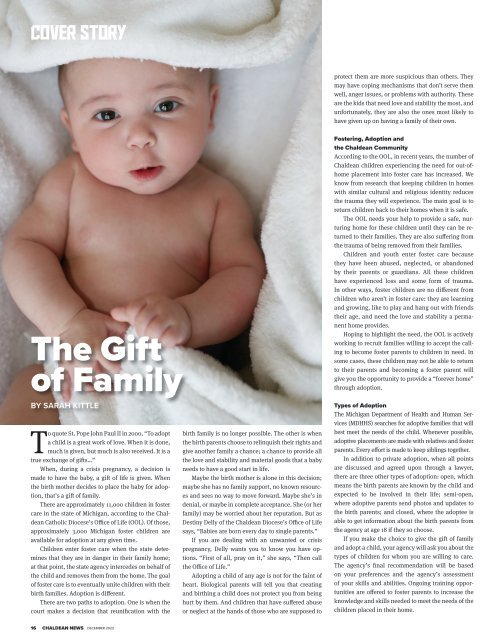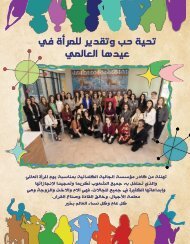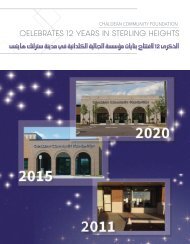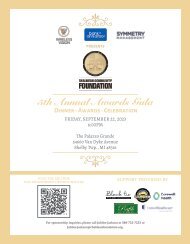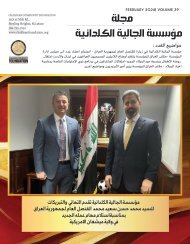Create successful ePaper yourself
Turn your PDF publications into a flip-book with our unique Google optimized e-Paper software.
COVER STORY<br />
protect them are more suspicious than others. They<br />
may have coping mechanisms that don’t serve them<br />
well, anger issues, or problems with authority. These<br />
are the kids that need love and stability the most, and<br />
unfortunately, they are also the ones most likely to<br />
have given up on having a family of their own.<br />
The Gift<br />
of Family<br />
Fostering, Adoption and<br />
the Chaldean Community<br />
According to the OOL, in recent years, the number of<br />
Chaldean children experiencing the need for out-ofhome<br />
placement into foster care has increased. We<br />
know from research that keeping children in homes<br />
with similar cultural and religious identity reduces<br />
the trauma they will experience. The main goal is to<br />
return children back to their homes when it is safe.<br />
The OOL needs your help to provide a safe, nurturing<br />
home for these children until they can be returned<br />
to their families. They are also suffering from<br />
the trauma of being removed from their families.<br />
Children and youth enter foster care because<br />
they have been abused, neglected, or abandoned<br />
by their parents or guardians. All these children<br />
have experienced loss and some form of trauma.<br />
In other ways, foster children are no different from<br />
children who aren’t in foster care: they are learning<br />
and growing, like to play and hang out with friends<br />
their age, and need the love and stability a permanent<br />
home provides.<br />
Hoping to highlight the need, the OOL is actively<br />
working to recruit families willing to accept the calling<br />
to become foster parents to children in need. In<br />
some cases, these children may not be able to return<br />
to their parents and becoming a foster parent will<br />
give you the opportunity to provide a “forever home”<br />
through adoption.<br />
BY SARAH KITTLE<br />
To quote St. Pope John Paul II in 2000, “To adopt<br />
a child is a great work of love. When it is done,<br />
much is given, but much is also received. It is a<br />
true exchange of gifts…”<br />
When, during a crisis pregnancy, a decision is<br />
made to have the baby, a gift of life is given. When<br />
the birth mother decides to place the baby for adoption,<br />
that’s a gift of family.<br />
There are approximately 11,000 children in foster<br />
care in the state of Michigan, according to the Chaldean<br />
Catholic Diocese’s Office of Life (OOL). Of those,<br />
approximately 3,000 Michigan foster children are<br />
available for adoption at any given time.<br />
Children enter foster care when the state determines<br />
that they are in danger in their family home;<br />
at that point, the state agency intercedes on behalf of<br />
the child and removes them from the home. The goal<br />
of foster care is to eventually unite children with their<br />
birth families. Adoption is different.<br />
There are two paths to adoption. One is when the<br />
court makes a decision that reunification with the<br />
birth family is no longer possible. The other is when<br />
the birth parents choose to relinquish their rights and<br />
give another family a chance; a chance to provide all<br />
the love and stability and material goods that a baby<br />
needs to have a good start in life.<br />
Maybe the birth mother is alone in this decision;<br />
maybe she has no family support, no known resources<br />
and sees no way to move forward. Maybe she’s in<br />
denial, or maybe in complete acceptance. She (or her<br />
family) may be worried about her reputation. But as<br />
Destiny Delly of the Chaldean Diocese’s Office of Life<br />
says, “Babies are born every day to single parents.”<br />
If you are dealing with an unwanted or crisis<br />
pregnancy, Delly wants you to know you have options.<br />
“First of all, pray on it,” she says, “Then call<br />
the Office of Life.”<br />
Adopting a child of any age is not for the faint of<br />
heart. Biological parents will tell you that creating<br />
and birthing a child does not protect you from being<br />
hurt by them. And children that have suffered abuse<br />
or neglect at the hands of those who are supposed to<br />
Types of Adoption<br />
The Michigan Department of Health and Human Services<br />
(MDHHS) searches for adoptive families that will<br />
best meet the needs of the child. Whenever possible,<br />
adoptive placements are made with relatives and foster<br />
parents. Every effort is made to keep siblings together.<br />
In addition to private adoption, when all points<br />
are discussed and agreed upon through a lawyer,<br />
there are three other types of adoption: open, which<br />
means the birth parents are known by the child and<br />
expected to be involved in their life; semi-open,<br />
where adoptive parents send photos and updates to<br />
the birth parents; and closed, where the adoptee is<br />
able to get information about the birth parents from<br />
the agency at age 18 if they so choose.<br />
If you make the choice to give the gift of family<br />
and adopt a child, your agency will ask you about the<br />
types of children for whom you are willing to care.<br />
The agency’s final recommendation will be based<br />
on your preferences and the agency’s assessment<br />
of your skills and abilities. Ongoing training opportunities<br />
are offered to foster parents to increase the<br />
knowledge and skills needed to meet the needs of the<br />
children placed in their home.<br />
16 CHALDEAN NEWS <strong>DECEMBER</strong> <strong>2023</strong>


